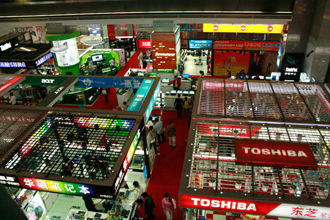Shenzhen’s electronics district, once a thriving marketplace for cheap knockoffs, is littered with empty stores as retailers struggle to compete against the popularity of the real deals from Apple and Samsung, according to the Beijing weekly Economic Observer.
At its peak in 2008 the Huaqiangbei district had managed to pack 700 busy electronics shops employing over 130,000 into a 0.74 square-mile area. Some of them were 100,000-square-foot megastores that helped attracted over a million customers a day to the district for annual gross revenues estimated at 26 billion yuan ($4.1 bil.)
The district was fed by factories in the nearby electronics manufacturing hub of Dongguan as well as merchants smuggling in goods from Hong Kong. Its reputation as China’s top market for pirated mobile phones added to its attraction among shoppers.
But the introduction of Apple iPhones into China in 2010, and the rising popularity of Samsung’s Android-based mobile phones — as well as the growing affluence of China’s consumers who can increasingly afford the real thing — is sapping many Huaqiangbei retailers of their reason for existence.
Now even the city government is hearing demands for removal of shops selling cheap knockoffs in order to clean up the district’s image and reposition it as a retail district selling quality goods. But many retailers have other ideas — they’ve turned to ecommerce as a way to expand their clientele to all of China, especially the less developed regions where cheap knockoffs seem remain appealing bargains. This trend may yet give Huaqiangbei a new lease on life as China’s ecommerce hub.


